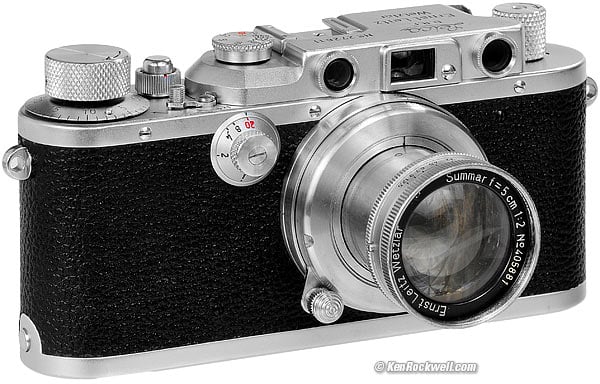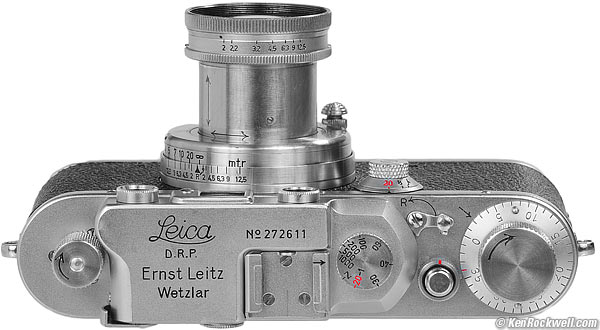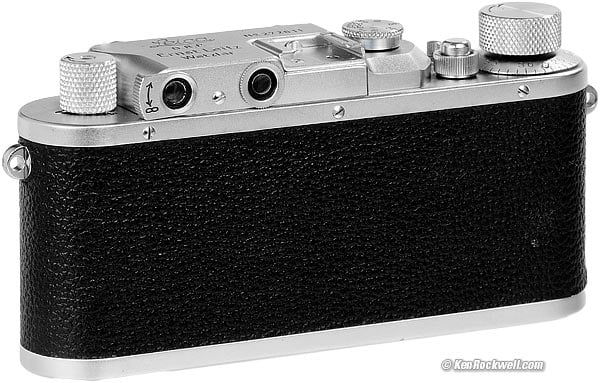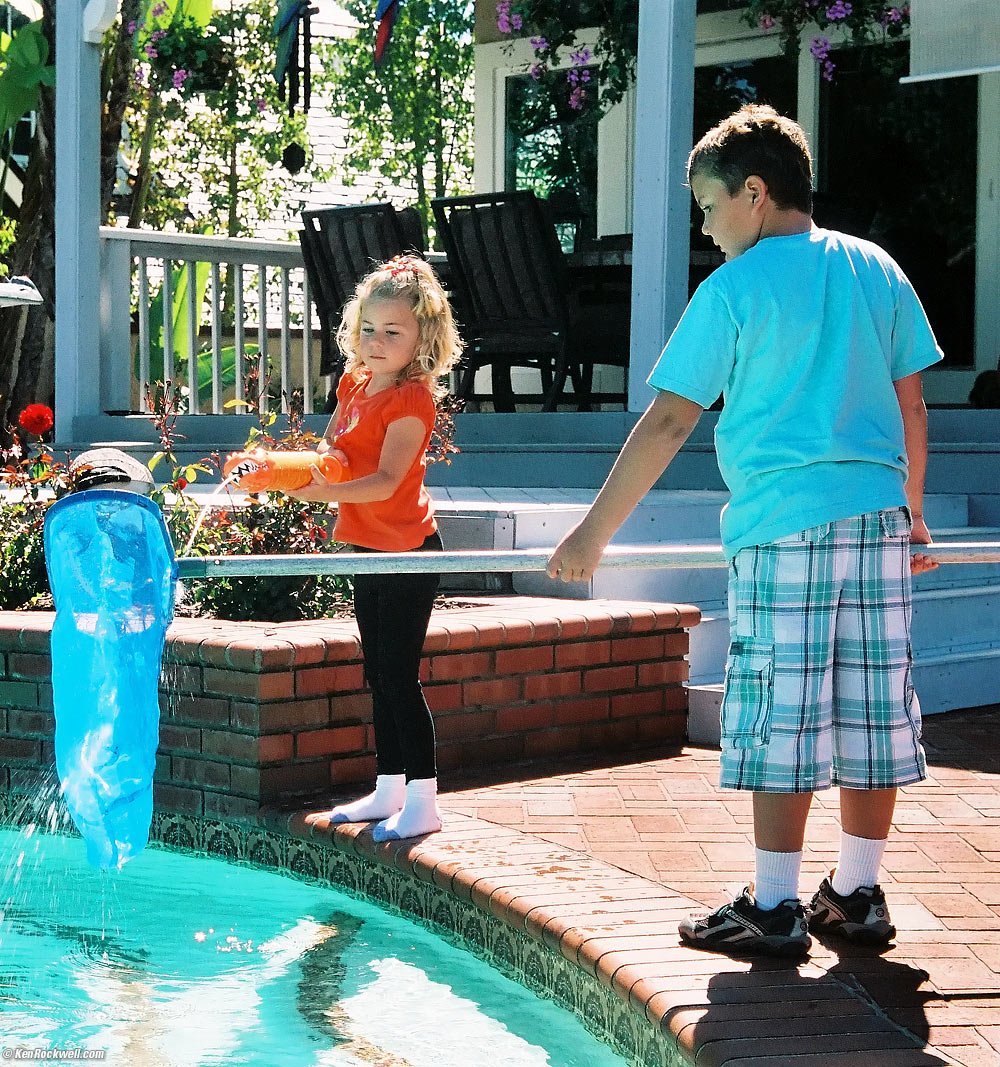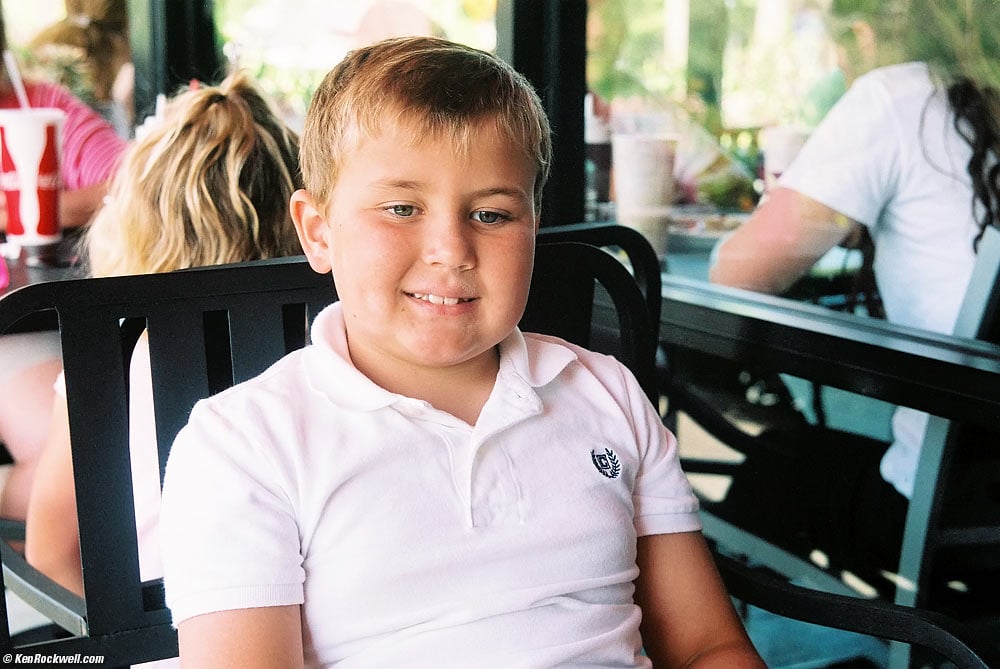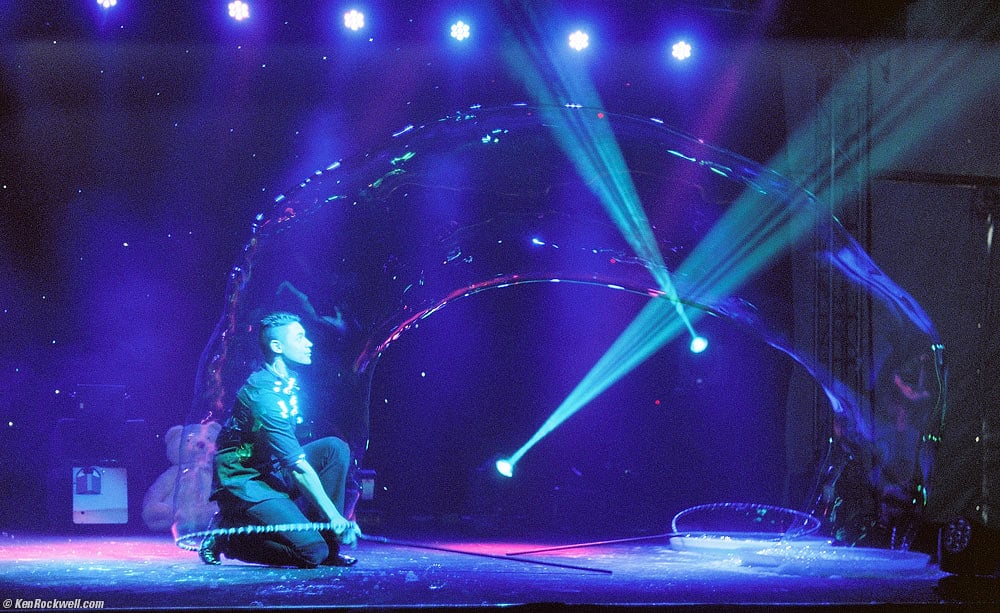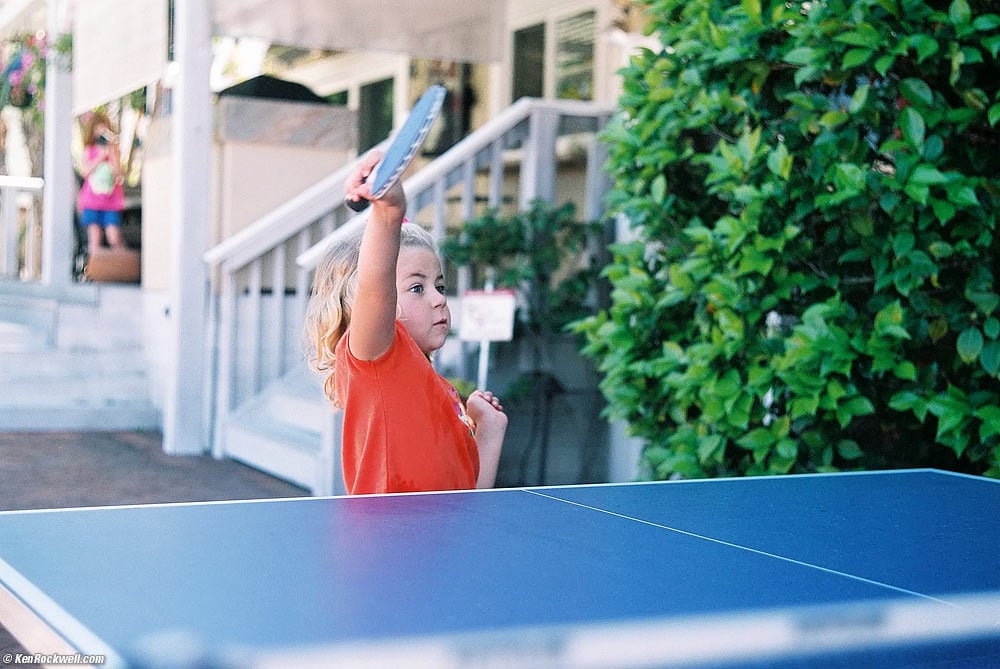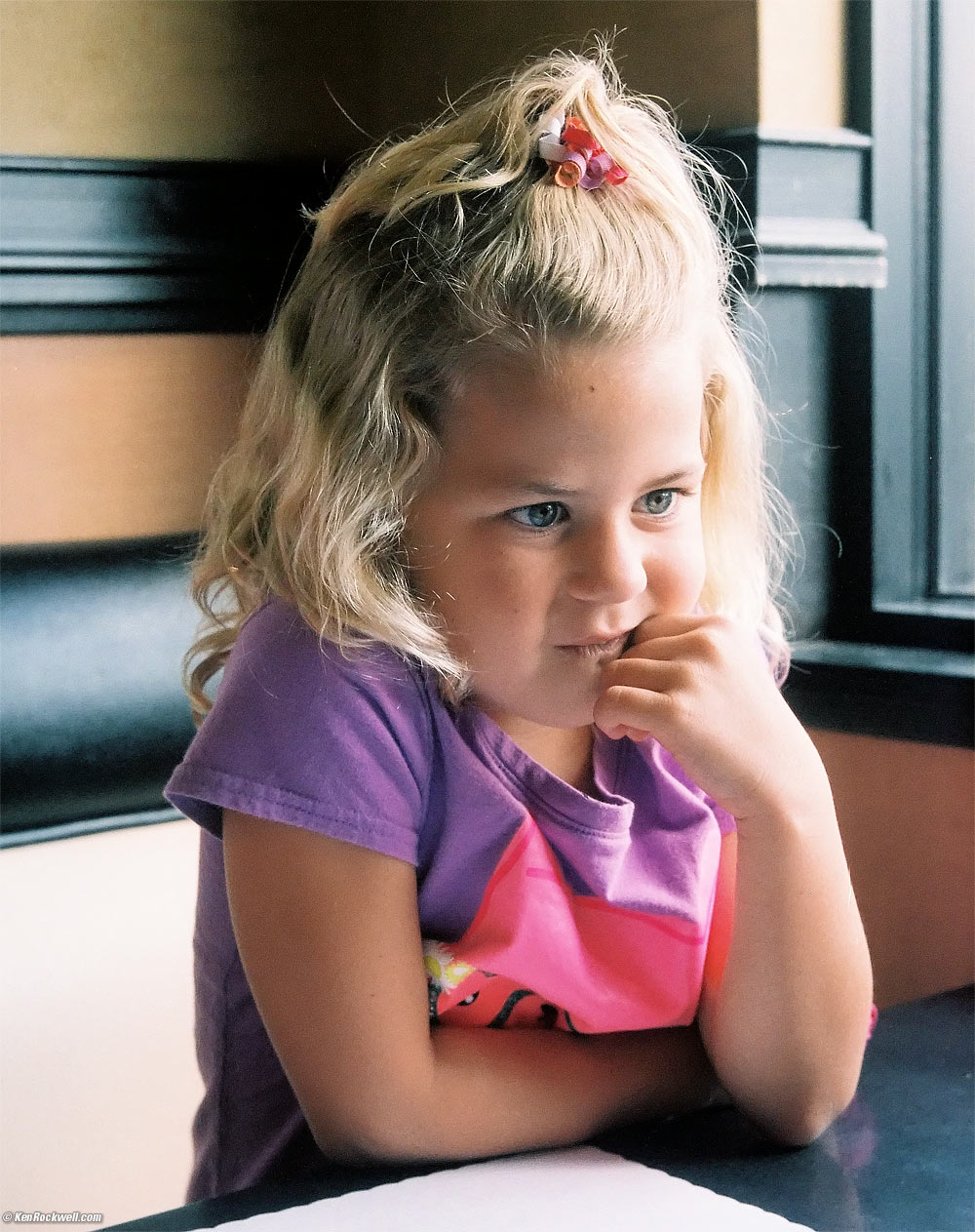Home Donate New Search Gallery Reviews How-To Books Links Workshops About Contact
LEICA IIIa
Autofocal Camera Model G (1935-1938)
© 2014 KenRockwell.com. This page best with Corporate S regular and bold activated.
Intro Specs Performance Compared Accessories
Usage Recommendations Service More
LEICA IIIa (15.252 oz./432.4g with film, about $250 used) with its original collapsible LEICA SUMMAR 5cm (50mm) f/2 (A36 filters, 6.2 oz./177g, about $175). This sample is from 1938, with its original lens from 1937. Body and lens as shown weigh 20.709 oz./587.1g with film. enlarge. These are easy to get at this link directly to them at eBay (see How to Win at eBay).
This free website's biggest source of support is when you use those or any of these links to approved sources when you get anything, regardless of the country in which you live — but I receive nothing for my efforts if you take the chance of buying elsewhere. I get no government hand-outs and run no pledge drives to support my research, so please always use any of these links to approved sources for the best prices, service and selection whenever you get anything. It helps me keep adding reviews of ancient equipment when you get yours through these links, thanks! Ken.
April 2014 LEICA Reviews LEICA Lenses All Reviews
Film specials: transparency (slide) film B&W film color print film
I've been getting my film directly from B&H and Adorama ever since the 1970s; you've never been able to get pro film at local retail stores. I use NCPS to process and scan all my film. If you're reading this you have a mailbox and can get all the film and processing you need; B&H and Adorama ship worldwide, and NCPS does mail-order work from around the world every day.
Shooting the LEICA IIIa digitally
Top, LEICA IIIa and collapsible LEICA SUMMAR 5cm (50mm) f/2. bigger.
Rear, LEICA IIIa. bigger.
Great for: Ultra-high quality images from the smallest and lightest possible camera. The LEICA IIIa is one of the least expensive ways to get into the LEICA system. The IIIa looks so crazy and ancient that no one will give you a hard time photographing with it. Superstitious people who confuse DSLRs with weapons are not afraid of the IIIa.
Not great for: Action, automation or fast shooting. The LEICA IIIa works great, but for practical photography, it requires about twice as many knobs and settings to do the same thing as a modern fully-manual camera requires.
Sample Image (more throughout the review)
Katie and Ryan clean Noni's pool, 10:43 AM, 07 April 2014. Cropped from 1938 LEICA IIIa and original uncoated 1937 LEICA SUMMAR 50mm f/2, Gossen DIGISIX, Fuji Superia 400, Costco Laguna Niguel/Heather Road process and scan, f/11 at 1/200, Athentech Perfectly Clear. bigger.
Introduction top
Intro Specs Performance Compared Accessories
Usage Recommendations Service More
This screw-mount LEICA IIIa is over 75 years old, and still works great today. It is a wonderful little camera that creates superior images that helped make LEICA a legend.
The IIIa is exceptionally small, light and precise and gives extraordinary images. It earned LEICA the reputation on which it slides today.
How small is it? The lens retracts, and then it fits in your pocket! It's light enough to carry all day and not feel it around your neck, as a camera should be.
The IIIa is a real Barnack-designed LEICA, designed and crafted in Wetzlar by a company that made more microscopes and precision instruments bought by large organizations than it made cameras for individuals. Thus the IIIa feels like the no-expense-spared precision optical instrument it is.
This camera's catalog price with the SUMMAR lens as shown was $4,000, adjusted for inflation. This was a very serious investment by any purchaser. The USA's Great Depression was its deepest in the early 1930s and most people were still very bad off in the late 1930s, and things were getting very bad in Germany in all of the 1930s. When this camera was made in 1938, Germany had just invaded the Sudetenland.
Anyone who was able to buy such as expensive a camera as this in the late 1930s was doing very well indeed.
This model was introduced the same year as the world's first practical color film, Kodachome, in 1935. Before 1935, color was still unheard of outside the research laboratory, and common B&W films were mostly sensitive to blue light so skies always looked washed-out. Panchromatic film sensitive to red light was still weird stuff back then.
The IIIa has everything I actually need. It is a testament to how camera makers have mostly just been adding fluff to their cameras for the past 80 years.
Ryan at Stacks, 11:36 AM, 10 April 2014. (1938 LEICA IIIa and original uncoated 1937 LEICA SUMMAR 50mm f/2, Gossen DIGISIX, Fuji Superia 400, Costco Laguna Niguel/Heather Road process and scan, f/6.3 at 1/100, 1.1 m focus, Athentech Perfectly Clear.
Timeline top
We call this a LEICA IIIa today, while when new it was sold as the LEICA AUTOFOCAL CAMERA MODEL G.
AUTOFOCAL means that focussing is automatic: just align the superimposed rangefinder images, and the camera is in focus. Simpler cameras demanded that you guess, tape-measure or use a separate rangefinder to measure the distance and then manually set it on the lens' distance scale. With this LEICA, focus is automatic with no need to look at distance scales.
This Model IIIa of 1935 adds the 1/1,000 shutter speed to the previous Model III (a.k.a. Model F) of 1933 , which it replaces.
The IIIa only came in chrome as shown here. If you see a black IIIa, it could be an earlier model III which LEITZ cheerfully updated to the IIIa.
The newer IIIb put the rangefinder and viewfinder windows closer together, and replaced this IIIa in late 1938.
The popular IIIc (1940-1951) added many small internal improvements, like a much more adjustable shutter system and better baffling to reduce film fogging.
The most popular IIIf (1950-1957) added flash synchronization.
The IIIg (1957-1960) added a 90mm frameline in the finder.
Compatibility top
The LEICA IIIa works perfectly with all LEICA screw-mount lenses. Current M-mount bayonet lenses do not fit.
If you're using anything other than a 50mm lens, you'll need to slip an external finder in the accessory shoe.
Newer bayonet M mount lenses do not fit, but all screw mount lenses sold since 1931 work and couple perfectly on all newer LEICA M cameras with a simple adapter ring.
Yes, a 1931 screw-mount lens on an adapter gives perfect exposure coupling and automatic exposure on the M7, M9 and M typ 240, exactly the same as a new lens.
Screw mount lenses are also called M39 by LEICA, as well as L mount, LTM (LEICA Thread Mount), 39mm x 1.0mm thread, LEICA Thread, and probably even other appellations.
This thread is still standard for enlarging lenses today, and some makers, like Voigtländer, still make screw-mount lenses because of their extraordinarily wide compatibility, even with today's cameras.
LEICA has occasionally offered some current lenses in this mount, most notably, the current versions of the extraordinary LEICA SUMMICRON 50mm f/2, LEICA SUMMILUX 50m f/1.4 and LEICA SUMMICRON 35mm f/2 ASPH.
Bubblefest, 12:55 PM, 05 April 2014. 1938 LEICA IIIa and original uncoated 1937 LEICA SUMMAR 50mm f/2, Gossen DIGISIX, Fuji 400H, Costco Laguna Niguel/Heather Road process and scan, f/2.8 at 1/40, Athentech Perfectly Clear. bigger.
Specifications top
Intro Specs Performance Compared Accessories
Usage Recommendations Service More
Flange Focal Distance
28.8mm.
(M-Kameras are 27.8mm.)
Rangefinder
1.5x magnification with an internal telescope.
Rangefinder focuses as close as 1 meter (3 feet).
The focusing adjustment for the telescope (needed to see the rangefinder clearly) is the small lever around the eyepiece.
38mm physical base length x 1.5x magnification = 57mm effective base length.
Here is the LEICA IIIa rangefinder's effective base length compared to newer LEICAs:
Physical Base Length |
Rangefinder Magnification |
Effective Base Length |
|
| IIIa | 38mm |
1.5x |
57mm |
| M3 | 69.25mm |
0.91x |
63mm |
| 0.85x | 69.25mm |
0.85x |
58.9mm |
| 0.72x | 69.25mm |
0.72x |
49.9mm |
| 0.58x | 69.25mm |
0.58x |
40.2mm |
Viewfinder
0.5x magnification.
Soft-edged image displayed against black.
Clean image, no framelines, no focus patches, no nothing except your image.
Covers 50mm (5cm) lens, only.
For other lenses, use the LEICA VIOOH Imarect finder (1940-1964), which gives more precise framing than even today's LEICA finders. The VIOOH's sharp-edged image is adjustable both for parallax, and also for magnification changes with distance. The VIOOH Imarect finder is so good that I also suggest it for use with LEICA M cameras for more precise results.
Shutter
Katie plays ping pong, 11:09 AM, 07 April 2014. 1938 LEICA IIIa and original uncoated 1937 LEICA SUMMAR 50mm f/2, Gossen DIGISIX, Fuji Superia 400, Costco Laguna Niguel/Heather Road process and scan, f/4 at 1/500, 2.1 m focus, Athentech Perfectly Clear. bigger.
Horizontal silk focal plane.
1 - 1/1,000, also Time (T) and Bulb (Z).
No self-timer.
Cable release: requires the same screwy nipple adapter as the Nikon F and Nikon F2, and you have to remove the collar around the shutter button to use it.
Tripod Thread
Professional 3/8."
Use a bushing to fit common 1/4" - 20 tripod heads.
Weight
Body only: 14.473 oz. (410.3g).
Body with 36-exposure film 15.252 oz. (432.4g).
Body and collapsible LEICA SUMMAR 5cm (50mm) f/2 as shown weigh 20.709 oz. (587.1g) with film.
Model Numbers and Prices (USA)
In 2014 the IIIa body sells for about $250 used, and the collapsible LEICA SUMMAR 5cm (50mm) f/2 as shown here sells for about about $175 used, if you know How to Win at eBay.
Here are the catalog prices from back when these were brand new:
IIIa body only (49 950 or LUOOB)
Price with inflation, 2014 |
(price in period dollars) |
|
5/1936 |
$2,128 |
$126 |
8/1936 |
$2,382 |
$141 |
4/1937 |
$1,956 |
$120 |
3/1938 |
$1,998 |
$120 |
IIIa body and ELMAR f/3.5 (49 970 or LEOOR)
Price with inflation, 2014 |
(price in period dollars) |
|
5/1936 |
$2,964 |
$175.50 |
8/1936 |
$3,344 |
$198 |
4/1937 |
$2,739 |
$168 |
3/1938 |
$2,797 |
$168 |
IIIa body and SUMMAR f/2 as shown (49 960 or LIOON)
Price with inflation, 2014 |
(price in period dollars) |
|
5/1936 |
$3,977 |
$235.50 |
8/1936 |
$4,307 |
$255 |
4/1937 |
$3,473 |
$213 |
3/1938 |
$3,547 |
$213 |
IIIa body and XENON f/1.5 (49 955 or LUOOX)
Price with inflation, 2014 |
(price in period dollars) |
|
4/1937 |
$4,891 |
$300 |
3/1938 |
$4,995 |
$300 |
Performance top
Intro Specs Performance Compared Accessories
Usage Recommendations Service More
Overall
I've covered most performance aspects in the Introduction. Here are some more.
The LEICA IIIa is quiet, compact, and as you'll see below, easy to use.
Technical performance is limited only by your choice of lenses and film, and mostly by your ability as a photographer.
Rangefinder
The dedicated, magnified rangefinder works great.
The magnified rangefinder and the viewfinder are two separate eyepieces. You look through one to focus, and move your eye to the other to compose and shoot.
The lever to focus the eyepiece rarely needs adjustment, and when it does, it's right by your thumb. I prefer this to the newer IIIf with its adjustment on the top of the camera.
The rangefinder is as or more precise than any modern LEICA M camera, however it is not more accurate.
The IIIa's rangefinder lacks the adjustability of M cameras. The IIIa's rangefinder can be calibrated at one distance, and that's about it. M cameras allow adjustability at more than one distance, so typically you won't get perfect focus at every distance with a IIIa if you're shooting test targets at f/2 and enlarging them 100x; but that's not what LEICA photographers do.
The rangefinder can be a bit dim in dim light.
It has a neutral color as most LEICAs; it's not yellow or blue.
Viewfinder
The viewfinder is brighter than LEICA M cameras because it has no need for the semi-polarization used when a rangefinder spot is added.
If has no rangefinder in it; it's just a soft-edged image in black.
The image is a small 0.5x image, sort of like a DX DSLR. There is only mild barrel distortion.
There is no blockage with the 50mm f/2 SUMMAR with A36 filter mount.
There will be a little blockage when a filter is attached, and minor blockage when used with newer E39 filter-mount lenses.
The viewfinder is so close to the lens that parallax isn't a big deal, but blockage will become a big deal if you try to get smart and use bigger lenses.
For bigger lenses, like the 5cm f/1.5 LEICA SUMMARIT, the external VIOOH finder is more precise, more accurate, and has no blockage problems.
Ergonomics
Katie at breakfast, 10:30 AM, 05 April 2014. 1938 LEICA IIIa and original uncoated 1937 LEICA SUMMAR 50mm f/2, Gossen DIGISIX, Fuji 400H, Costco Laguna Niguel/Heather Road process and scan, f/8 at 1/100, 1.0 m focus, Athentech Perfectly Clear. bigger.
No menus and no batteries means no problems!
The slow speed dial and frame counter are matte silver and easy to read.
The shiny turned-chrome fast-speed dial is nearly impossible to read in direct sunlight from the glare; shield the camera with your body and it's much easier to read in the resulting diffuse light.
Noise and Vibration
The LEICA IIIa is at least as quiet as LEICA M cameras, and many times more quiet than the noisy digital LEICA M9.
Shutter Gate Opacity
The shutters are opaque, but light can work its way around the bottom of the curtains to fog to top of your image if you're not careful to keep the lens capped when not in use outdoors.
Newer models like the IIIc and IIIf are better at this.
Frame Counter
The line for 36 is in red, but it's not noticeably red in actual use.
You have to reset the frame counter to zero manually for each roll of film, however it is much larger and easier to read than automatic-resetting counters that only show a few numbers at a time. Since you always can see the entire frame counter dial, it's easy to see the "roll at a glance."
Film Economy
38 or 39 frames on a 36-exposure roll.
27 frames on a 24-exposure roll.
Rewind Time
About 30 seconds.
Stealth
This is a goofy-looking old camera.
Normal people won't even give you the time of day if they notice you carrying it, which fits in exactly with my genius plan.
Compared top
Intro Specs Performance Compared Accessories
Usage Recommendations Service More
This LEICA IIIa is significantly smaller and lighter than any LEICA M camera. It's so light that I often forget it's around my neck. The LEICA IIIa is what a camera should be: small, simple, lightweight and a dream to carry all day so it's always with you.
The LEICA IIIa is quieter than LEICA M cameras, so in other words, the IIIa does what they do best, but even better. It is many times quieter than the clattery digital LEICA M9.
The LEICA IIIa has a smaller, but brighter, viewfinder than any LEICA M. This is because the IIIa's viewfinder is separate from the rangefinder, so it doesn't need the darkening that newer cameras need to ensure contrast against the rangefinder spot. The rangefinder is a separate magnified window.
The IIIa weighs only two-thirds as much as a typical LEICA M. It weighs only half as much as most DSLRs, and less than one-third what a pro DSLR weighs, and delivers better image quality.
It is the same shape as LEICA M cameras, but is it slightly smaller in every dimension. LEICA M cameras are bigger than screw-mount cameras, and digital M cameras have gotten even slightly bigger.
The LEICA IIIa has a 1.5x magnified rangefinder with a longer effective baselength than most LEICA M cameras to give more precise focus, and therefore sharper pictures.
The LEICA IIIa's rangefinder has significantly longer effective base length than any digital LEICA M like the LEICA M9.
Canon made a copy, the Canon IIIa, which offers a variable-magnification finder for 50mm, 100mm and 135m lenses!
Deployment top
Intro Specs Performance Compared Accessories
Usage Recommendations Service More
Straps
I suggest using the current LEICA strap, which attaches instantly without tools or marring the camera.
Light Meters
Real photographers have enough experience to know the correct exposure settings based on conditions. For instance, indoors is f/2.8 at 1/30 at ASA 400.
Learners who need light meters have many choices. LEICA made LEICAMETERs which slipped in the accessory shoe.
Today, learners use the Gossen DIGISIX and optional shoe adapter to pop it in the accessory shoe. You won't be able to see the setting of the shutter dial under the DIGISIX if you use it in the accessory shoe.
I leave the DIGISIX set to ISO 100, so the LV numbers are universal. I transpose them in my head for the ASA in use. This way I always know when readings are wrong, and can guess well, too, since the same number always corresponds to the same light.
If you use an iPhone or iPod Touch, the Pocket Light Meter application works great, once calibrated.
Lenses
Most lenses screw-in so that their top index marks are at about the one o'clock position, not straight up. This is so you can see them when you have accessories in the shoe.
Original LEICA screw mount lenses are at least 50 years old today. You'll need to check them with the flashlight test. Most will have some haze, and often this isn't a problem. If it is, Gus Lazzari can almost always clean it out.
LEICA made a very limited run of modern 50mm f/2 SUMMICRON-M, 35mm f/2 SUMMICRON ASPH and 50mm f/1.4 SUMMILUX lenses in screw mount. It is unlikely you'll come across any of these, but if you do, they offer the best performance. I still wouldn't suggest either current 50mm even if you can find them: each is so much bigger than 1950s lenses that you'll have half of the camera's finder blocked, and they are so heavy that they pretty much destroy the whole point of this ultralight camera. You'll need an external finder with any of these. See my LEICA SUMMICRON-M 50mm f/2 (M39) page for specifics.
The best lens for the IIIa is a 50mm. It's the only lens you really need, and the only lens covered by the built-in viewfinder.
As 50mm lenses made in screw mount go, the best common lens is the 50mm (5cm) f/2 collapsible LEICA SUMMICRON. It came in both screw and bayonet mount; you of course need the screw mount.
The big problem with the common 50mm LEICA SUMMICRON, made from 1953-1957, is that the front element is made of glass as soft as chalk, so every sample by now has gotten dull from over 50 years of rough cleaning.
It will take you a few months of looking at this direct link to it at eBay to find a good one (see How to Win at eBay). Expect to pay about $500 for a nice one if you find it, or about $250 for one with worn glass as almost all are. Unscrupulous dealers call the ones with dull front elements "coating" or "cleaning" marks; run away from those.
LEICA made the optically superior rigid 50mm f/2 SUMMICRON lens in screw mount, but they will cost you because they are rare.
The 50mm f/2.8 ELMAR is very good, and most are in good condition.
Heck, even the original 50mm f/3.5 ELMAR (1925-1961) is a swell performer, even uncoated! I have an 80 year old one from 1934 and it works great. The only gotcha with the original f/3.5 ELMAR is that the aperture is adjusted on the front of the lens, so you have to pull the filter every time you want to adjust it.
You can get either ELMAR for about $250 in very nice shape, and it's what I'd suggest unless you want to look for a year for a clean SUMMICRON. Then again, with film, you'll want f/2.
For a lens faster than f/2, you're looking at the LEICA SUMMARIT 5cm (50mm) f/1.5. Its performance isn't that great, but more seriously, its big 41mm bayonet filter front will block much of the camera's finder image, asking for the use of an external finder, and the dedicated 41mm bayonet filters, mandatory for most photography, haven't been made in 50 years. This SUMMARIT is also prone to worn and hazy glass, so I'd spend my time trying to find a good sample of the much more practical f/2 SUMMICRON.
The original SUMMAR lens (1932-1939) with which I shot this IIIa is also super sharp; just not as sharp as the SUMMICRONs. Likewise, the old SUMMITAR (1939-1953) is also superbly sharp in the center where it matters, all up to modern day standards.
For a wide lens, there are plenty of 35mm (3.5cm) f/3.5 screw mount lenses. The best is the SUMMARON; the ELMAR was much earlier and crummier. Expect to pay about $300 for a nice one, as most are.
For a tele, get the 90mm (9cm) f/4 ELMAR. Expect to pay about $150. It is sharpest when stopped down.
Most older screw mount lenses use push-on A36 filters,named for the lens' 36mm outer diameter. For these lenses, use either hard-to-find A36 filters, or the LEITZ SOOGZ adapter for standard 39mm filters.
The LEICA VIOOH Imarect finder (1940-1964) is needed for any lenses other than 50mm. I got mine at this direct link to it at eBay (see How to Win at eBay). It gives more precise framing than the built-in viewfinder. It's better than any modern LEICA M finder, so it's a great idea to get one. The VIOOH's sharp-edged image is adjustable both for parallax, and also for magnification changes with distance.
For the best results with the VIOOH finder, be sure to set its own parallax distance adjustment manually before each shot.
Do not soil your LEICA by attempting to attach rubbish from the likes of modern-day Voigtländer. Why would you want to waste your time, insult your camera and look foolish in front of your friends? The real reason to shoot with a LEICA IIIa is to use LEICA's superior optics, not to waste film with dinky lenses.
Lens Hoods
With uncoated lenses like the SUMMAR, I use its big dedicated rectangular hood.
I don't worry about them with coated lenses, since round hoods block the finder.
Tripods
The LEICA IIIa uses a professional 3/8" thread.
Use a bushing to use common 1/4" - 20 tripod heads.
Usage top
Intro Specs Performance Compared Accessories
Usage Recommendations Service More
Read the LEICA IIIa user manual.
Light Meters and Exposure
I use this Light Meter app or the Gossen DIGISIX.
LEICA's manual suggests for the films of the 1930s, to use 1/30 to 1/60 outdoors and to vary the aperture based on lighting outdoors. LEICA suggests using 1/200 and 1/500 speeds for sports shot wide-open (films in the 1930s were about ASA 32). For distant snapshots, focus at infinity and use f/6.3, and for portraits, shoot wide open.
Film Loading
Very early samples may have a slightly different part in the film chamber (visible with the bottom off) that prevents standard preloaded 35mm casettes from loading. The larger V1 part is designed for LEICA's reloadable casettes which were more popular in 1935. A different part, V2, was slightly smaller and allows today's standard preloaded cassettes to be used. Most IIIas had these parts changed by LEICA when in for service decades ago, but if for some reason your cassette won't drop in, be sure to see page 11 of the LEICA IIIa user manual which shows what these parts should look like.
There is one very important trick that I didn't notice until I noticed this message on the bottom of the camera as I was struggling to load it:
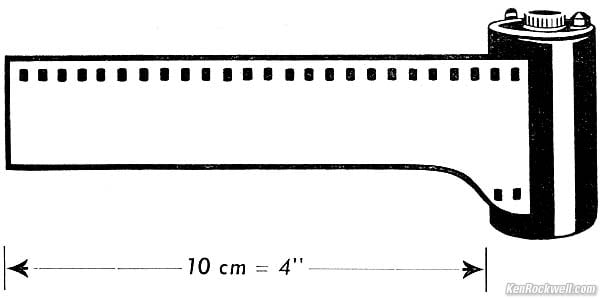
Film must be trimmed to have a longer leader, and exactly two perforations must show at the bottom.
If you don't trim your film properly to provide a longer leader tongue, the film will get jammed in the gate and not load. Standard out-of-the-box film will not load properly until trimmed.
If you do trim your film, it slides right into the IIIa and loads very easily.
To trim it, I count back 13 perforations along the bottom, and cut it out with my Swiss Army knife. Be sure not to cut across a perforation, as the edge might get caught trying to load. Leave two perforations pulled out of the canister out at the bottom as shown above, and you're good to go.
LEICA fanatics use the special ABLON cutting guide (Nr. 68,320, $27.00 corrected for inflation in 2009 [$1.80 in 1939 dollars]). If you shoot a lot, the ABLON is nice because the film drops right into perfect position with little tits that poke in the perforations. The ABLON comes with its own cutter in its own small leather case, bravo!
People who don't read directions go through all sorts of dangerous antics, like sticking their fingers through the shutter, to try to load the film improperly.
The reason you need to make the leader longer is because the film has to slide past the film gate, with the pressure plate in place. The back does not swing open.
When you trim your film properly, there is no bottom edge that has to jump over the other film rail, which is what hangs-up people who don't read directions.
When properly trimmed film is loaded, only after it's in place do you advance the full width of the film over the gate, so all works as The Prophet intended.
Now that you know this, you'll be fine as you read the printed manual to load the film.
In a nutshell, first trim your film. Then set the advance-rewind lever (by the shutter button) back to "A," remove the bottom plate, remove the take-up spool, slide the film leader under the clip of the take-up-spool, drop both film canister and take-up spool into the camera at the same time (turn the rewind knob is it doesn't drop down; this is also where it jams if you didn't trim your film), make sure the sprocket is engaged in a perforation by turning the film advance slightly, pop on the cover, wind the film, lift and set the advance knob film reminder, and then set the frame counter to zero. Easy.
Rewinding
To unload, set the advance-rewind lever by the shutter to R for rewind, pull up the rewind knob, and have at it.
The dot on the collar around the shutter release button rotates as you rewind, and stops just before the last of the film is drawn back into the cassette.
Film Fogging
If you're not careful, daylight can work its way around the bottom edge of the shutter curtains and fog the top of an image.
To avoid this, keep the lens capped or stopped-down and shielded when carried around outside, and keep the lens collapsed to prevent light from being able to make it to the bottom edge of the shutter curtains.
Lens Mounting
This couldn't be easier: they screw on and off.
Use the infinity lock to lock the focus ring, and only then grab the lens to remove it. The infinity lock is designed to take the torque; the stop of the focus helicoid is not.
The lens tubes of collapsible lenses should be drawn forward and locked during mounting and unmounting.
If you really want to follow proper LEICA procedure, align the lens' focus knob with the viewfinder window as you present it to the camera.
Don't allow direct sun to hit the naked shutter when lenses are removed. Keep the IIIa in your shadow.
The index marks usually stop to the left of center so that you can read them with accessories in the shoe.
Focus
First look through the rangefinder (the leftmost peephole) and move the lever around the eyepiece so that the image is clear. This focuses the 1.5x telescope of the rangefinder so you can see it at different distances.
Once the rangefinder itself is in focus, focus the lens until the two images coincide.
It's easy to focus with both eyes open.
For action, it's OK to shoot while looking through the rangefinder window.
Shutter
The shutter dial cannot be set unless the film is wound. Don't try to move it when the shutter is uncocked.
Once wound, lift the dial and turn to set it.
The top shutter dial won't rotate between Z and 1/1,000.
Keep your fat fingers away from the top shutter dial when firing. It is connected directly to the shutter rollers and spins as the shutter exposes your film. If you obstruct it, you'll get weird exposure.
There are two shutter dials: one on top for the fast speeds, and one on the front for the slow speeds.
For fast speeds, set them on the top dial.
For slow speeds, set the fast dial to "20-1" and set the speed on the slow dial.
Good news: you may set any speed in-between 1/8 and 1 second on the slow dial. (The fast speeds only work at the detents.)
For Bulb, set it as Z (Zeit) on the fast dial, with the slow dial set to 20.
For Time, set the fast dial to "20-1" and the slow dial to T. The shutter opens and stays open until you move the slow-speed dial away from T.
Leave the IIIa uncocked when you put it away. My service man, Gus Lazzari, recommends that the shutter not be left cocked for more than 6 hours at a time. Try to put it away uncocked.
No LEICA has a shutter-cocked indicator, but with experience if you look at the fast speed dial you'll be able to see if it's cocked or not by whether or not it's in a reasonable position.
Cable Release
To use a cable release, LEICA says you have to unscrew the cover around the shutter button and get a screw-on nipple adapter. It's the same as the adapter for the Nikon F and Nikon F2.
I haven't tried this.
LEICA suggests to hold the fast-speed dial while removing the cable release.
Viewfinder
The built-in 50mm finder is optimum between 9 to 12 feet.
You'll get more on your film at infinity.
You may get less on your film between 3 to 6 feet.
Accessory Viewfinders
With the LEICA IIIa, you have to use accessory finders for any lens other than 50mm.
This is not a problem, since the best photographers use nothing but a 50mm lens anyway. Accessory finders are a pain. Orthodox shooters are quick to point out that the main reason LEICA invented the M series with multiple-frameline finders was so that LEICA could sell more lenses, not because it lead to better pictures.
Flash
Forget using flash, there are no sync contacts. For flash, you want the LEICA IIIf (1950-1957), which adds this.
With the IIIa, use the Z (bulb) setting, open the shutter, fire the flash manually, and close the shutter.
Recommendations top
Intro Specs Performance Compared Accessories
Usage Recommendations Service More
The LEICA IIIa is a wonderfully small, quiet and ultra-high quality camera.
Since they are at least 75 years old today, you will probably want to send it out for an overhaul before using it. I have Gus Lazzari service my LEICAs.
See Accessories for suggested lenses and more.
Service top
Intro Specs Performance Compared Accessories
Usage Recommendations Service More

Many thanks also to Gus Lazzari for doing a complete overhaul on this IIIa so I could review it here.
Gus, America's leading LEICA specialist, completely renovated my IIIa.
Remember if you send him yours for service that he does all the work himself, so it takes a while for him to give each camera the care it deserves.
More Information top
Intro Specs Performance Compared Accessories
Usage Recommendations Service More
Help me help you top
I support my growing family through this website, as crazy as it might seem.
The biggest help is when you use any of these links when you get anything, regardless of the country in which you live. It costs you nothing, and is this site's, and thus my family's, biggest source of support. These places have the best prices and service, which is why I've used them since before this website existed. I recommend them all personally.
If you find this page as helpful as a book you might have had to buy or a workshop you may have had to take, feel free to help me continue helping everyone.
If you've gotten your gear through one of my links or helped otherwise, you're family. It's great people like you who allow me to keep adding to this site full-time. Thanks!
If you haven't helped yet, please do, and consider helping me with a gift of $5.00.
As this page is copyrighted and formally registered, it is unlawful to make copies, especially in the form of printouts for personal use. If you wish to make a printout for personal use, you are granted one-time permission only if you PayPal me $5.00 per printout or part thereof. Thank you!
Thanks for reading!
Mr. & Mrs. Ken Rockwell, Ryan and Katie.
Home Donate New Search Gallery Reviews How-To Books Links Workshops About Contact

